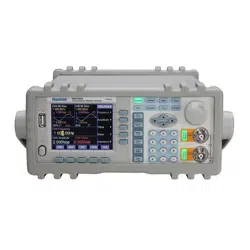Loading ...
Loading ...
Loading ...

3.2.2 Set the Period of Channel A
The frequency of the channel A can also be set and displayed in the way of period. Select “Period” by the
corresponding soft key. The current period value changes to yellow. Input a new period data here by numeric
keypad or rotary dial. Press the key corresponding to the period time units to confirm the new data input.
However, the instrument still uses the frequency synthesis internally and the input data is just converted to the
correct value when it is input and displayed. Due to the limitation of the lower resolution at low frequency, when
the period is too long, the function generator can only generate the frequency points with the longer period
interval. Although the preset and displayed period is precise, the actual period of the output signal has the
relatively big variation. Users shall pay attention to this point.
3.2.3 Set the Amplitude of Channel A
Select “Vpp” or “Vrms” by the corresponding soft key. The current amplitude value changes to yellow. Input a
new amplitude data here by numeric keypad or rotary dial. The function generator outputs the desired signal at the
CHA Output.
The input and display of the Channel A amplitude value have two formats: Vpp and Vrms. Press key [Vpp] or
[mVpp] after numeric input to input and display amplitude peak-to-peak value. Press key [Vrms] or [mVrms]
after numeric input to input and display amplitude true RMS value.
Although the amplitude value has two formats, the instrument still uses the peak-to-peak format internally and
makes the format conversion on the data input and the data display. Due to the limitation of the amplitude
resolution, there is a difference between the format conversions. For example, if the Vpp of sine wave is 1Vpp, the
Vrms conversion value is 0.353 Vrms. If the Vrms of sine wave is 0.353Vrms, the Vpp conversion value is
0.998Vpp. In most of cases, this difference is within the error range. If the square waveform is selected, the
conversion factor is 2. The Vrms format can only be used at the “CHA Alone” mode and the waveform selected as
sine or square wave. For other operations and waveforms, only peak-to-peak format can be used.
3.2.4 Amplitude Attenuation
Select “Offset” by the corresponding soft key, next select “Attenuation” by the corresponding soft key. Input a
new attenuation value here by numeric keypad or rotary dial. Press the soft key corresponding to [dB] to confirm
the new data input.
After instrument power on or reset, the attenuation is default in “Auto” mode. In “Auto” mode, the instrument
automatically selects suitable attenuation ratio according to preset amplitude values. When the output amplitude is
at 2V, 0.2V, or 0.02V, the instrument switches between attenuation ratios. In this situation, the instrument
generates a waveform of high amplitude resolution, high signal & noise ratio, and low distortion, regardless of
signal amplitude values. However, during attenuation ratio switch, there is instant hopping in the output signal,
which is not allowed in some practices. That is why the instrument has preset with fixed attenuation mode.
Select “Attenuation” by the corresponding soft key. An attenuation data can be input here by numeric keypad or
rotary dial. There are five ranges of attenuation: 0dB, 20dB, 40dB, 60dB and AUTO, which can be input by
numeric key 1, 2, 3, 4 and 0 respectively plus the soft key corresponding to [dB]. The attenuation mode can also
be selected by rotary dial. One step in rotary dial tuning goes to one range. If a fixed attenuation mode is selected,
- 12 -
Loading ...
Loading ...
Loading ...
